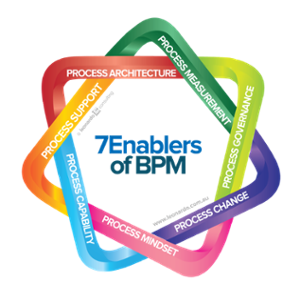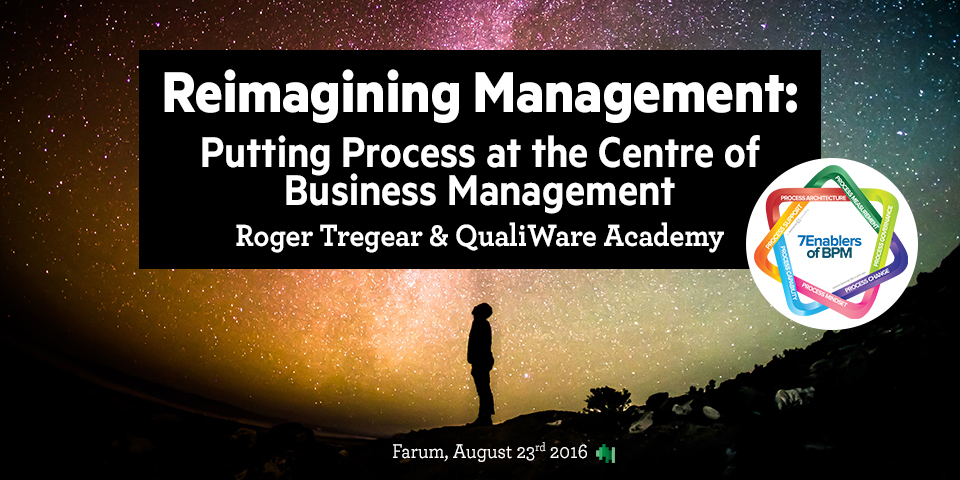Collaboration
Idea
In an Innovation Canvas, the “Idea” symbol represents a specific concept or solution that could potentially address a particular problem or opportunity. This symbol is depicted as a lightbulb.
The Idea symbol is used to capture and communicate a creative solution or approach that may be developed further into a tangible product, service, or business model. It may include a brief description of the concept, as well as any unique features or benefits that distinguish it from other ideas.
7Enablers of BPM
7Enablers Deep Dives: Process Architecture and Process Measurement.
There are seven elements, the 7Enablers of BPM, that come together to create and sustain process-based management:
- Discovery, understanding, and documentation of the organization’s processes and related resources in a hierarchical model—process architecture
- Defining process performance measures and measurement methods, collecting and reporting process performance data—process measurement
- Reimagining, and responding to, process performance anomalies, innovation opportunities, and general process hygiene—process governance
- Continuously finding ways to close process performance gaps by eliminating problems and capitalizing on opportunities—process change
- Creating an environment where the organization, its people, and their teams are always conscious of the processes in which they participate—process mindset
- Developing the tools and skills required throughout the organization to identify, analyze, improve, and manage business processes—process capability
- Providing the support required throughout the organization to develop, sustain and realize the benefits of process-based management—process support
The first three enablers—architecture, measurement, governance—are tangible, whereas the final three—mindset, capabilities, support—are more abstract (but no less important). Change is in the middle and is the central objective of process management.
To thrive, perhaps even to survive, in times when ‘doing more with less’ seems both inevitable and impossible, executives need to step back from day-to-day functional issues and reimagine their organizations as value creation and delivery flows. Process-based management delivers a practical, proven approach and the 7Enablers of BPM represents a breakthrough in management practice.
These enablers are shown in the image above. A Mobius strip format is used to highlight the interdependencies between the elements. The enablers are interconnected—change one and one or two others are likely changed, change several and they will all be changed. The 7Enablers represent the key levers of process-based management.
The core enabler is the process architecture since documenting the key processes is the necessary first step. Once documented, processes can be measured and once measures are available, governance arrangements to define who should respond to performance reports and change opportunities are required. These first three enablers (architecture, measurement, governance) are the ‘physical infrastructure’ on which the rest is built. Continuous process change is the cornerstone of process-based management. Without process improvement, both small changes and large innovations, what is the purpose of process analysis and management? For process management and improvement to become ubiquitous, it must be embedded in the organization culture and mindset. Having a central specialistsupport group to do all process work, does not scale and will soon impose a bizarre restriction on process management and improvement work. Therefore, it is necessary to build the capability for identifying, analyzing, improving, and managing business processes throughout the organization.
The 7Enablers is a collective of mutually supportive prerequisites for successful and sustained process-based management.
Read more in Roger Tregear’s blog post introducing 7Enablers
Each of the 7 enablers will be described in further details. So far, two of the enablers have been described:
Reimagining Management
The only way any organisation is able to create, accumulate, and deliver value to its customers is via collaboration across the organisation. There is no other way. Can any box on your organisation chart, by itself, deliver value outside your organisation? No, it can’t. This is the meaningful message of process-based management.
Roger Tregear
Leonardo Consulting
What will I learn in the seminar?
In a day packed with pragmatic wisdom and practical case study examples, you will learn:
- How organisational strategy is executed via business processes
- Why only cross-functional processes can deliver value (products & services) to customers
- Why process-based management allows managers to focus on the things that really matter
- How the process view provides an effective framework for business requirements analysis
- How to build awareness of performance and quality in every person across the organisation
- How the 7Enablers defines, measures, improves, and maintains organisation performance
- Why continuous improvement needs both performance-driven and idea-driven pathways
- How the Virtuous Circles sustain effective process-based management
The 7Enablers is a systemic framework for sustained transformative management, replacing ‘random acts of management’ with commitment to deliberate operational excellence.The 7Enablers is a systemic framework for sustained transformative management, replacing ‘random acts of management’ with commitment to deliberate operational excellence.
When and where?
23 August 2016 at QualiWare HQ at Ryttermarken 15 in Farum.
Participation
The course fee is 5000 DKK plus VAT (if applicable). The fee includes seminar participation, breakfast and lunch, course material, and an optional follow-up visit by a QualiWare BPM expert.
Roger Tregear is a Consulting Director with Leonardo Consulting. He delivers BPM education and consulting assignments worldwide. Based in Canberra (Australia), Roger spends his working life talking, consulting, thinking and writing about the analysis, improvement, innovation and management of business processes.
Collaboration: The Key to Successful Enterprise Architecture
Market dynamics force enterprises to implement changes at a faster rate than ever. Because of this, most changes are implemented reactively which has many negative impacts, such as significant negative impact on employee trust. This can be combated by focusing on stakeholder involvement. Such engagement is best achieved by implementing a collaboration-enabled EA initiative. QualiWare focuses on enabling enterprises to implement positive change by fostering collaboration via the QualiWare platform. This focus has conferred QualiWare customers with a plethora of benefits, ranging from better employee and customer satisfaction to improved audit results.
[eyesonly logged=”in”] DOWNLOAD THE WHITEPAPER[/eyesonly] [eyesonly logged=”in” hide=”yes”] Log in to download the whitepaper
Don’t have an account? Sign up for a free account.
[/eyesonly]



